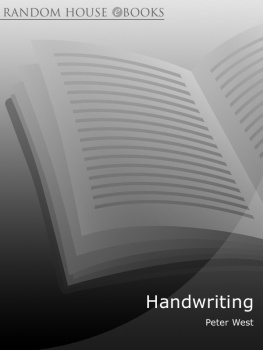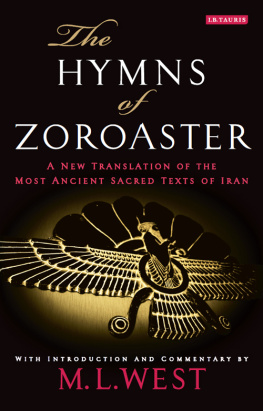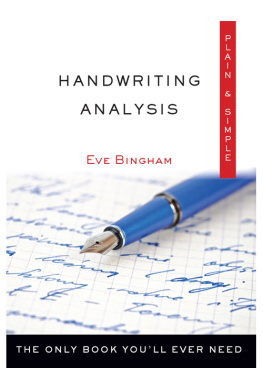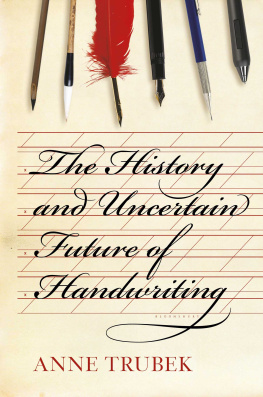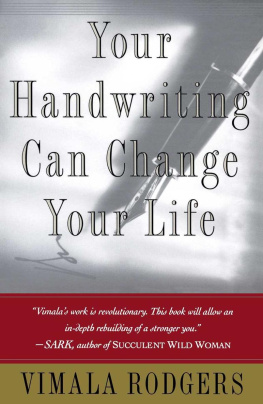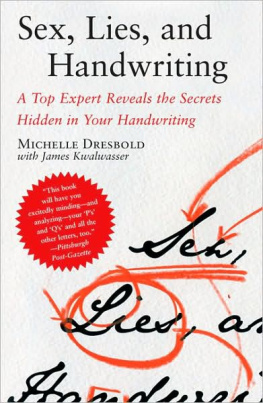Contents
Before reading further, write a short note to someone you know reasonably well.
Make it at least 75100 words in length on a sheet of A4 unlined paper. Dont worry too much about content and try to write in your usual style, but when you sign it, date it as well. Put it in an envelope and put the envelope somewhere safe until you have read this book.
This is probably your last chance to write with an unprejudiced hand.
Introduction
Handwriting is a most personal method of communicating, particularly when emphasized with a signature. Society and the law recognize this as being a unique and unmistakable form of identification: to forge either can incur severe punishment in most civilized countries.
In acknowledging this feature of handwriting we are also saying that it reflects character and personality. Note how easily we recognize the styles of friends and relatives just by looking at the envelope when we receive our post. We extend this exercise to assess the script of strangers and, by following set procedures laid down by years of experience and study, we can arrive at certain conclusions regarding their character and personality. This suggests a scientific basis for analysis. However, there is also an art to interpreting character from handwriting using these rules. Thus graphology, like astrology or chirology, may be termed an art-science.
One cannot use it to foretell the future, although a graphologist may be able to accurately assess the reactions of a particular writer if and when certain conditions arise. One cannot use it to identify the sex or the age of a writer, nor tell if he or she is left-handed. There may be tell-tale signs of extreme youth or old age, but few left-handed writers can be detected.
Basically, handwriting reflects the mood and thinking of the individual at the time of writing. Therefore, writing may vary slightly according to how the writer feelsand this will have a bearing on the formation of the script.
Of course, much may depend on to whom and for what purpose the handwriting is being executed: a letter to a friend, a request for some information, a message giving information, a love letter or a job application. A graphologist will rarely be concerned with the subject matter, for it may be misleading. Every part of the sample should come under scrutiny.
Ideally, a sample will be at least 75100 words in length, on unlined paper at least A4 size. It should wherever possible include a signature. The writer should use a ball point or fountain pen, not a pencil or a fibre-tip pen, and should not copy from a book or magazine. The sample should be in prose form, not poetry, and it is preferable to use one that has been written naturally, such as a recent letter, and not one that has been written specifically for the purpose of analysis.
The best place to start is at the end and then work back towards the beginning. This may sound like strange advice, but it isnt. Most writers, whatever their subject or reason for writing, tend to be self-conscious at the beginning but become less so as the work proceeds. Once you become involved with your message, you become less involved with the construction of the actual script. The result is that the end of the majority of samples is likely to be more naturally executed than the beginning.
It is important to remember that each sign, trait or clue must be treated as such. An occasional sign may mean just that. You must also remember that all facets of personality have positive and negative aspects.
Observe and evaluate the whole sample, never just a part; learn to balance and counterbalance. Take up a pen and trace a line or word for yourself. See how the original was created.
Handwriting assessment is a logical process. Tidy writing may indicate a tidy mind, but it may also show a tendency to timidity. Hopeless scrawls do not always refer to poor education; it may be that the mind operates so swiftly the hand simply cannot keep up, the result being an illegible mess. By tracing a word here and there you will begin to understand your subject more fullya picture of the personality will begin to build up as you progress.
A signature represents the outer image that the writer wishes to present to the outside world. Often, people will use two different signatures, one for formal or business correspondence, the other for more private, personal matters. Caution, therefore, should be exercised when looking at a single example, particularly when you dont have any other writing from the same source.
The main body of the text will provide information on the physical, mental and emotional state at the time of writingthe inner man or womanand the signature will reflect the outer image. Later, we shall see how to detect conflict, if any, between the two.
The finer details of analysis require division of the component parts of the script; slant, zones, size, loops (or lack of them), connectedness, style, form level, capitals, margins, legibility, speed, and punctuation. Handwriting may appear thick or thin, be spaced widely or in narrow form. There may be little flourishes at the beginning or end of words or letters, which, to the untrained eye, mean little. Even the colour of the ink and the way numbers are formed tell their part. An envelope will give interesting clues as well.
Some experts suggest that there is inevitably some form of control in the way an envelope is addressed: it is not so spontaneous as the letter it contains. Nevertheless, comparison between the writing on the envelope and the message inside can often be very revealing.
Handwriting is a silent and expressive gesture that none of us can afford to ignore. People study handwriting for a variety of reasons.
There are specially trained experts who have no interest in character analysis. They are concerned with the technical and forensic analysis in fraud or forgery cases, and may be required to give evidence in a court of law. Very few of these specialists are approved by the Law Society.
The calligrapher is a master of fine writing. He or she can create certain pen strokes which appear at first to be quite simple. Further enquiry proves the opposite: it is a challenging and difficult art that takes time and patience to perfect and usually requires a degree of natural talent and artistic skill for success. The uses of calligraphy are many: announcements, brochures, certificates, memorials, scrolls and testimonials are but a few.
Graphologists use handwriting to further knowledge of others as well as themselves. Frequently employed by business organizations in matters of personnel selection, graphologists are used to assess employees for a variety of reasons.
Marriage-guidance counsellors may also be trained to determine the degree of compatibility between prospective divorcees, much as single folk may wish to discover potential risks in their relationships prior to marriage.
Child-guidance clinics may use specialists to analyse the writing of a child for clues that may reveal tendencies quite unsuspected by parents or teachers.
There are few areas of behavioural science where handwriting experts may not be employed.
By explaining a little in this introduction about what handwriting analysis is and what is required to utilize it, I have tried to whet your appetite for what is to come. You will have all the necessary information should you choose to take the subject further and experiment for yourself.
I think you will.
Slant: The Writing Slope
HANDWRITING DEVELOPS THROUGHOUT childhood almost from the first days at primary school until the student leaves at sixteen or older. Individual abilities are established at more or less the same time, particularly if teachers are astute enough to ensure that their charges progress in such a way that no one gets left too far behind. However, this is not always the case. Where one child will strive to do his best to write as nicely as possible, another may rush, producing a distorted form of what is expected.
Next page
